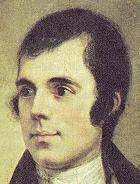|
|
Chapter six English
Literature of the Romantic Age
Ⅰ The Pre-Romantic Poets
1. Robert Burns(1759-96)
Life

Robert Burns was the eldest son of a poor tenant
farmer of Scotland. He spent his youth working his father’s farm, but in
spite of his poverty he was extremely well read - at the insistence of his
father, who employed a tutor for Robert and younger brother Gilbert. At 16
Robert became the principal laborer of the family and this prompted him to
start writing in an attempt to find “some kind of counterpoise for his
circumstances.” It was at this tender age that Burns penned his first verse,
My Handsome Nell, which was an ode to other subjects that dominated
his life—that is Scottish matters. When his father died in 1784, Robert and
his brother became partners in the farm, and began the hard struggle with
poverty. In order to search a living, Burns decided to go abroad in 1786. He
collected some of his early poems and published them in order to get some
money for his journey—that is Poems— Chiefly in the Scottish
Dialect—Kilmarnock Edition. This collection made him famous within one
night. Then encouraged by this great success and together with pride of
parenthood, he stayed in Scotland. He moved around the country, eventually
arriving in Edinburgh, where he mingled in the circles of the famous artists
and writers who were excited at the “Ploughman Poet.” In a matter of weeks
he was changed from local hero to a national celebrity. However, the fame
did not bring fortune to him, and soon he felt himself an alien in
aristocratic circles. In anger and disappointment, he went back to the soil.
He spent the last few years in a gloomy situation.
Although he took up a job as an excise man in 1789 and gained a small
salary, he was still in the struggle with poverty. His openly support of the
French Revolution both in conversion and in verse brought him into much
trouble. In 1796, after a long term of heart disease because of the hard
manual work, he died aged 37 when still very young. On the day of his bury,
more than 10,000 people came to watch and pay their respects. However, his
popularity then was nothing compared to the heights it has reached since. On
the anniversary of his birth, Scots both at home and abroad would celebrate
Robert Burns with a supper. He has become the pride and symbol of Scottish
people.
According to the different subject matters,
Burns’ poetry can be divided into various groups.
A. Many of Burns’ poems are lyrics on love and friendship. They vividly
describe Burns’ own feelings and emotions with simple, musical language.
This carries a new blow into the British literature—the wind of Romanticism
that later prevail the main stream of English literature in early the 19th
century. A Red, Red Rose is the best representative of his lyrics.
B. Burns is called the son of Scotland, because he wrote many patriotic
poems to his motherland. My Heart’s in the Highlands is the best
known of this kind that shows his deep love for his native land.
C. Because of his deep love of Scotland, Burns was proud of the Scottish
culture. He then wrote a lot of verse tales that based on Scottish legends.
In these verses, he highly praises the unconquerable spirit of the Scottish
people in their struggle against the oppressors and invaders. Bruce at
Bannockburn is the best example.
D. As a humble peasant, Burns wrote many poems to express the common
feelings of millions of working people: their customs and
traditions—particularly the Scots’, their hatred for the oppression of the
ruling class and their love for freedom. Most of these poems are irony or
sarcastic. A Man’s a Man for a’ That and The Slave’s Lament are the
good instances of this kind.

|
![]()
![]()